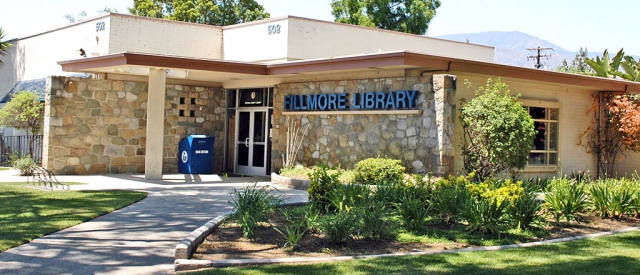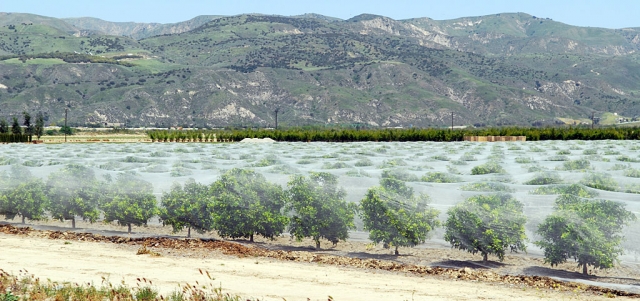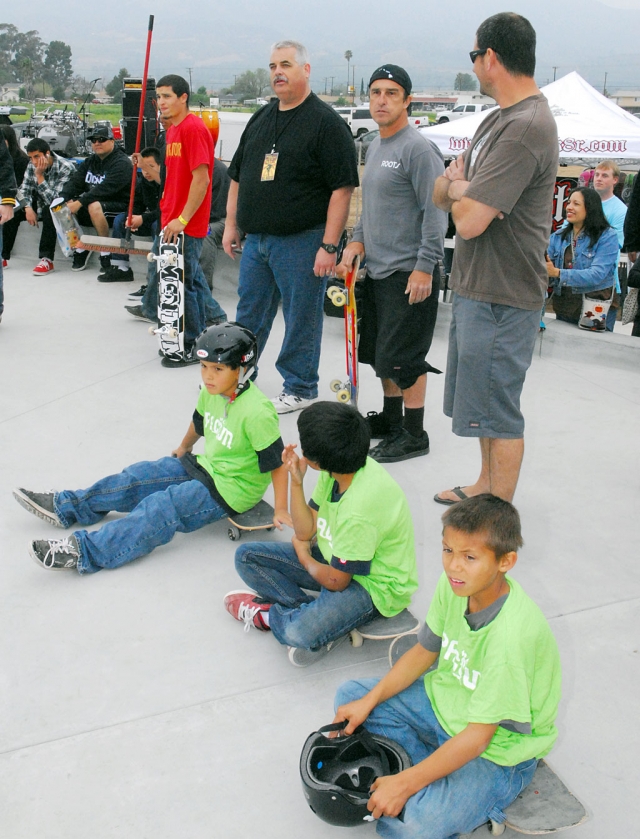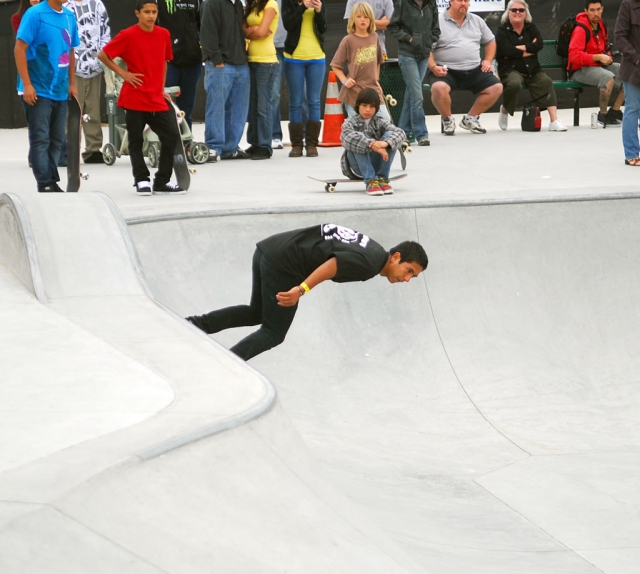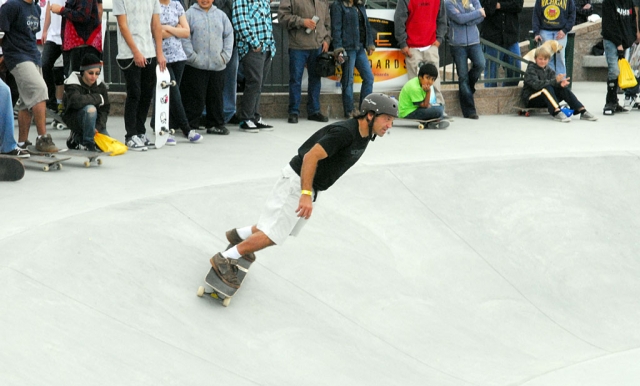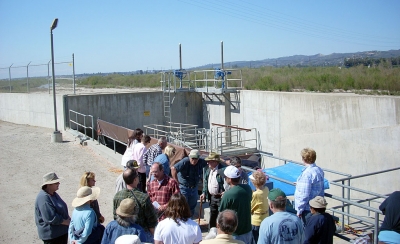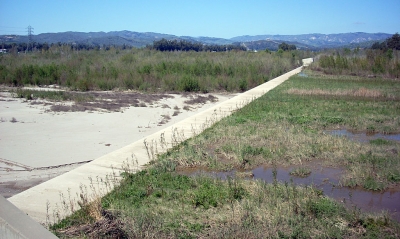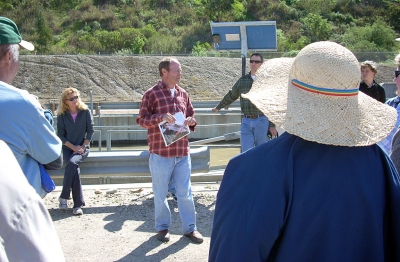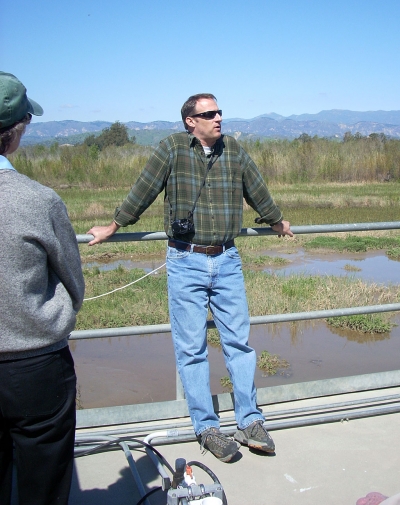|
By Joyce Schifanelli — Wednesday, April 1st, 2009
Twenty years and counting
We have all heard stories of good coming from tragedy, and “Friends of the Library” began just that way. In December 1985, Fillmore residents Roberta Nelson and her husband Charles, a local veterinarian, lost their cherished adopted son John in a private plane crash during a blinding snowstorm, en route to a Christmas skiing vacation in Utah. In lieu of cards or gifts, Roberta, a kindergarten through second grade teacher for many years, and later, Curriculum Coordinator and Material Specialist at San Cayetano Elementary School, requested cash donations, to purchase books in John’s memory for the Fillmore Library. Honoring her son and reflecting her own interest in the betterment of the community, Roberta and a small committee began organizational efforts for the Fillmore Chapter of the Friends of the Library. During the next four years, Roberta, Myrna Taylor, Judy Dunst, Betty Rubel, Helen Knight, Janine Rees, Mary Winterstein and Betty Hardison spent untold hours contacting librarians and chapter presidents for guidance. Rees and Isabel Galvan contacted local clubs, while County Librarian, Betty Cook, handled publicity and filed the Federal and State forms for tax exemption and non-profit status. The organizational committee met on April 19, 1989, elected its first official officers, and incorporated on March 20, 1990. CONTINUED » |
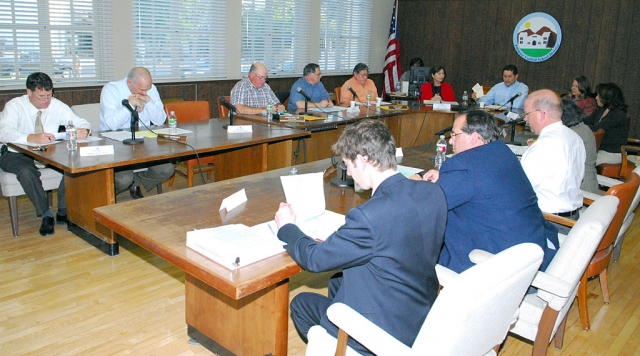 A Joint Fillmore City Council/School Board meeting was held Tuesday March 31st. Several people spoke at the meeting in regards to use of the new track. Enlarge Photo By Mariandrea Mueller — Wednesday, April 1st, 2009
The Fillmore Unified School District (FUSD) Board and Fillmore City Council sat together in a joint meeting on Tuesday, March 31, 2009. This was the first joint meeting of the two bodies since the Council changed over after the November 2008 election. Joint meetings had been scheduled earlier in the year, but were postponed on account of scheduling conflicts and lack of urgent business by mutual agreement. Tuesday’s agenda included forging a cooperative bond, planning community access to Fillmore High School’s all-weather track, directing City staff regarding traffic safety for Mountain Vista students, discussing the Military banner project, and status updates on the Water Recycling Project construction and the Fillmore pool. After considerable discussion amongst themselves, the Board and Council made separate but coordinated decisions to proceed with a pilot program for community use of the FHS track. Interim City Manager Bill Bartels announced that the City would be opening up the Fillmore pool to individuals for adult lap swimming sessions sometime in April. To facilitate fee management, security, and statistical analysis of usage, the City has purchased a key card system with management software. Because a back path connects the pool to the FHS track, the key card gate could provide restricted access to the pool and track during adult lap swim. Members of a City-founded running club will receive key cards. Bartels and Assistant Superintendent Mike Bush are working together to iron out the details. The Board has decided that the pilot program will provide access to the track from 6 a.m. to 8 a.m. because FHS is not using the track area at that time. The Board has a policy against allowing outsiders on the track during team practices, but agreed to reconsider that policy at a future Board meeting when coaches would be present to provide feedback. The Council directed City staff to investigate the community’s needs and include consideration of afternoon or evening accessibility in its proposal. Interested runners and walkers should contact Bartels. CONTINUED » |
|
By Anonymous — Wednesday, April 1st, 2009
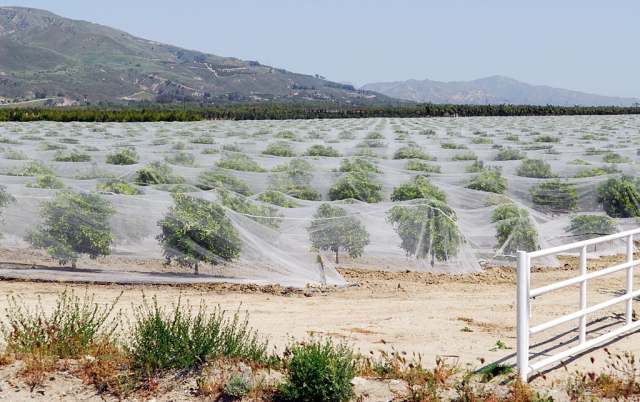 Shown is a large net-covered citrus orchard on Highway 23. The netting is meant to keep bees from pollinating seedless orange/tangerine trees. At issue are beekeepers who prize orange blossom honey and citrus growers who blame the bees for causing otherwise seedless citrus fruit to develop pips. Enlarge Photo |
|
By Anonymous — Monday, March 30th, 2009
Two arrested
Unit Responsible: Fillmore Gang Unit (S)uspects, (V)ictims, (W)itnesses, Address, Age On Sunday, March 22, 2009, at about 9:45 p.m., Sheriff’s deputies were dispatched to the 1000 Block of King St. in Fillmore to investigate the assault of two adult males. Deputies arrived to find that both victims suffered moderate to serious injuries from being kicked, punched and hit with a rock by the assailants. In the investigation, deputies discovered that gang members had attacked the two victims in two separate but related incidents. The first occurred in the 1000 block of King Street and the second followed in the 600 block of Lemon Way in Fillmore. The Fillmore Gang Unit investigated the case, which led to the arrest of two juveniles who are known Fillmore gang members. Both juveniles were charged with battery resulting in serious injury, participating in a criminal street gang crime, and conspiring to commit a crime; all felony offenses. The two juveniles were lodged into juvenile hall. The attacks are still under investigation and gang investigators expect to make more arrests in the case. |
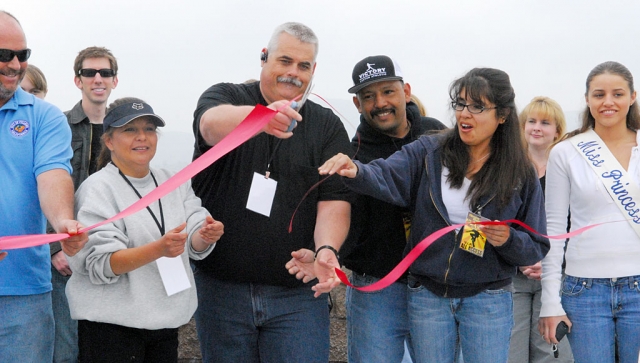 Pictured above are City Attorney Ted Schneider, Councilmembers Laurie Hernandez and Steve Conaway, David Lugo, former councilmember Cecilia Cuevas, and Jayme Harter, Miss Fillmore Princess. Skate Park Opening Facts: Special Appearances / Pro Skaters / Skater Personalities include: Tony Alva, Jeff Tatum, Per Welinder, Michael Early, Brad Edwards, Greg Fountain, Matt Bloise, Steve Badilla, Tony Alva was the first World Stake Board Champion in 1977. He is one of the most influential skate boarders of all time. He held the world record for jumping barrels according to Guinness Book of World Records. He was the first skateboarder to start his own company and brand his name. Tony continues to skate to this day and can skate with the best of the best. He is a friend of Fillmore and has skated the Fillmore park on several occasions. Jeff Tatum designed the Fillmore Skate Park. Jeff was one of the Down South boys who called San Diego home. He has an underground reputation. Jeff is a talented skate board artist. His designs can be seen on Pool King boards and some will be designing boards for Tony Alva. Per Welinder is a prior Free Style skate board champion from skating early days. He has been featured in numerous skate videos and was the stuntman for “Back to the Future” skating scenes. He formed Birdhouse Project with his partner Tony Hawk. Brad Edwards skates for Gravity Skate Boards. He is the worlds premiere longboard pool rider at this time. He skates for fun and infectious with his attitude and ability to inspire others. Greg Fountain skates for Pool King Skate Boards and has been featured in magazines and countless websites. Park Designed by: Jeff “the original longboarder” Tatum. Brought to life by: Scott Rice at Community Works Design Park Built by: California Skate Park Park size: Approximately 22,000 sq/ft. It took approximately 13 months from the redesign to the soft opening of the park. El Pescador fed the VIPs. Thanks to Rigo Landeros for his contribution and support. Enlarge Photo By Anonymous — Wednesday, March 25th, 2009
New Skateboard Park may be best in state
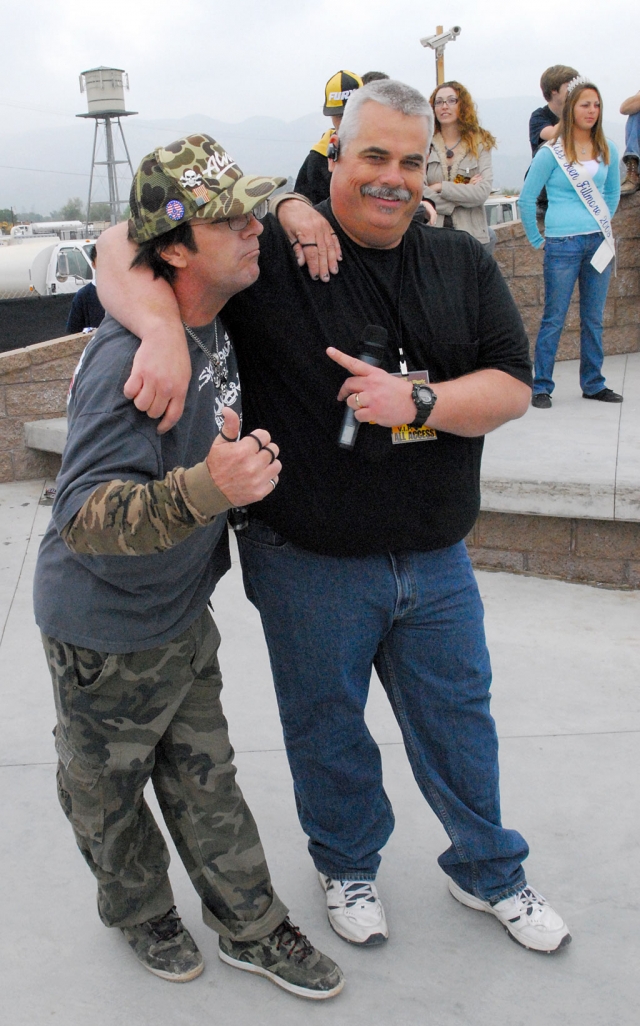 Councilmember Steve Conaway, right, found a new buddy in skater Jeff Tatum at Saturday’s grand opening. Enlarge Photo 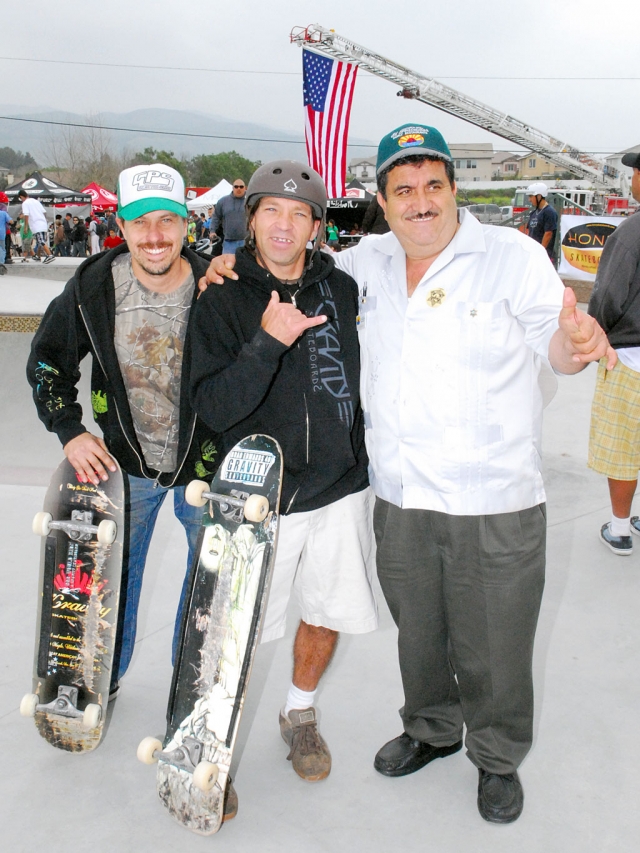 Right, Jesus “Chuy” Ortiz, owner of El Pescador, is pictured with skate pro’s at the new skate park. Enlarge Photo |
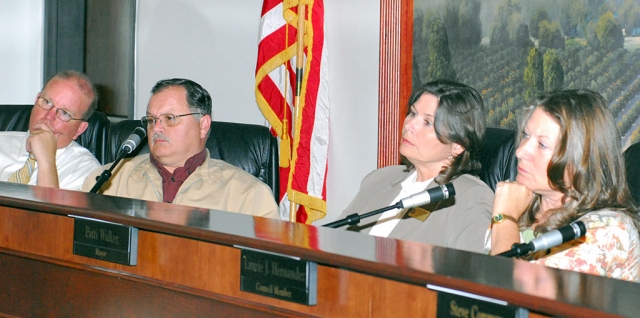 From left to right: Interim City Manager Bill Bartels, Council members Jamey Brooks, Gayle Washburn and Mayor Patti Walker. The three council members glossed over the possible half-million dollar cost of implementing Measure I, which each promoted last November. Enlarge Photo By Mariandrea Mueller — Wednesday, March 25th, 2009
The City Council meeting was well-attended on Tuesday, March 24, 2009. Many were there to comment on the implementation of Measure I. The Council decided to move forward on implementing Measure I, re-named River Park, avoided delays in the Business Park development by providing for Well #9, decided not to purchase property to straighten the B St. extension, and came to an agreement with 4H for use of the Equestrian Center. Police Chief Tim Hagel reported on 2008 Crimes Rates. Crime in Fillmore is down 15% overall from 2007 levels, Hagel reported. There were 2248 arrests and 2493 traffic citations in 2008. Hagel explained that the department's policy of frequent probation searches (targeting violent probationers) is proactively keeping drugs, weapons, and gang members off the streets. The arrest rate for probation searches is 28%. According to Hagel, an unrecorded telephone hotline for reporting gang activity is also reducing crime. He said that the FBI requires reports on significantly serious crimes, and Fillmore's number of crimes reported to the FBI is down 35% compared to 2007. Property crimes are down 11%. Hagel noted that police and fire response times are averaging under 3 minutes, and Fillmore residents seem comfortable calling on and making reports to the police. The Council's discussion about how to implement Measure I began with Community Development Director Kevin McSweeney's presentation on the changes required as a consequence of Measure I. Then the Council heard public comments before voting on a recommended course of action. CONTINUED » |
 Above the diversion channels river water to the spreading grounds, large shallow reservoirs composed of sand and gravel layers that naturally filter water as it seeps back into the ground. Enlarge Photo By Margie Bartels — Wednesday, March 25th, 2009
Ask any farmer or rancher in Ventura County, “What is the most important issue you face today?”, and the answer will probably be “water.” Without a consistent and adequate supply of water, agriculture cannot exist. The ongoing drought has led to drastic cutbacks in water allotments to farmers in the San Joaquin Valley, many of whom depend on water from the State Water Project or the federal Central Valley Project for their survival. So who manages our water here in Ventura County? You may have heard of the United Water Conservation District (UWCD), but are not sure what it does. How about the “Freeman Diversion”—where is that and what does it do? These questions, and more, were answered on a recent Saturday tour to the Freeman Diversion in Saticoy sponsored by the Ventura County Chapter of California Women for Agriculture. Ken Breitag, UWCD Executive Coordinator, explained the history of the UWCD, which is a public agency organized as a special district in Ventura County. Its territory covers the Santa Clara River watershed from the Los Angeles County line to the ocean. What started in 1927 as the Santa Clara River Water Conservation District by residents and landowners to manage the natural water supply and to protect it from outsiders seeking to export it, was restructured as the UWCD in 1954 to not only manage, but also to conserve, protect, and enhance the water supply. A seven-member Board of Directors (local resident Dick Richardson is a member) guides the agency in the management of its facilities in Saticoy and El Rio, as well as the Santa Felicia Dam, Lake Piru, the Freeman Diversion, and the pipeline distribution system which delivers surface water from the Santa Clara River directly to farms on the Oxnard Plain and Pleasant Valley areas. The UWCD also provides potable water to the City of Oxnard, the Port Hueneme Water Agency (including Naval Base Ventura County), and several small mutual water companies. It is funded by groundwater pumping charges, property taxes, water delivery charges, recreational fees, hydroelectric revenues and assessments. Ken discussed one of the biggest challenges facing the UWCD today—groundwater management and recharging, and salt water intrusion. The aquifer under Ventura County stores groundwater, our primary water source, which is pumped out of the ground from water wells for agriculture and domestic use. Rainfall helps to replenish groundwater, but is not enough to compensate for the water used, resulting in overdrafting of groundwater. When groundwater is overdrafted in areas close to the ocean, salt water can seep in, resulting in contamination of water and soil. In addition, crops have changed substantially over the last twenty years, especially in the Oxnard Plain. Strawberries demand heavy water usage in October when planted, so if enough surface water is not available more groundwater is pumped, increasing the likelihood of salt water intrusion. So what is the solution to this problem? More surface storage of water, and that’s where the Freeman Diversion and the Saticoy spreading grounds come in. Originally water diversion structures were earthen, which diverted about 43,000 acre-feet of water from the Santa Clara River per year. (One acre-foot of water will supply a family of four for one year). As these were vulnerable to destruction in flood years, the present concrete barrier structure was completed in 1991 at a cost of $31 million; now approximately 81,000 acre-feet of water replenish groundwater each year. The Diversion is 1200 feet long and 60 feet high (to bedrock), with 25 feet of that above the surface of the river. A plaque at the Saticoy site commemorates the “Freeman Diversion Improvement Project, constructed by UWCD, 1988-91, dedicated to the memory and water resources achievements of Vernon M. Freeman, Engineer-Manager from 1927-32.” The Diversion channels river water to the spreading grounds, large shallow reservoirs composed of sand and gravel layers that naturally filter water as it seeps back into the ground. Water stored in Santa Felicia Dam and Lake Piru is also released periodically down Piru Creek into the Santa Clara River where the Piru, Fillmore, and Santa Paula groundwater basins are recharged before the water meets the Freeman Diversion. Ken said that though our seasonal rainfall totals have improved with recent rainstorms, Lake Piru is at less than 50% capacity now. UWCD was able to keep up with irrigation water demands in the Oxnard Plain last fall, he said, but there is much concern about this fall, so they have established a moratorium on new connections to the Pumping Trough Pipeline, one of UWCD’s two agricultural pipelines, and are working with those growers to improve practices and maximize efficiencies. Ken stated that UWCD also has rights to 3,150 acre-feet of state water annually, but in 2009 is currently due to get only 15% of that. Invasive species are also a big concern, specifically the quagga mussel. According to Ken, these pests are now found “in basically every reservoir that receives Colorado River water.” They reproduce rapidly, especially in California water that is warmer and has a higher calcium level; one mussel can produce one million eggs per year! They will affix themselves to any surface, and could literally choke off the UWCD pipelines if they established themselves there. Maintaining vigilance and routinely inspecting pipelines and facilities for this creature is a priority. The tour group then caravanned the two miles to the fish ladder, and Ken introduced Steve Howard, UWCD Fisheries Biologist. An ongoing controversy in California is the rights of fish vs. the rights of people to the limited amount of water in our state. Southern California steelhead trout were listed as an endangered species in 1997. Steelhead are the ocean-going version of rainbow trout. Like salmon, steelhead live in the ocean, but when they migrate upstream to spawn in fresh water they produce young rainbow trout. Some of these young rainbow trout may in turn migrate back to the ocean to become steelhead, but others may live out their lives in fresh water as rainbow trout. It is not yet clear what determines whether young rainbow trout become steelhead or remain rainbow trout, but more is being learned, and UWCD hopes to contribute to this effort. At the fish ladder (a channel allowing adult fish to swim and leap up a series of low steps to bypass the barrier and continue upstream) a high-tech acoustic camera captures images of steelhead and every other aquatic creature accessing the ladder. Steve reported that relatively few steelhead are seen at the ladder, and it has been a subject of debate among UWCD, federal agencies and environmental groups as to what the natural population of steelhead trout is. All agree that steelhead trout are native to the Santa Clara River, but understanding the extent of that population has been severely hampered by massive plantings over the years of steelhead and rainbow trout from hatcheries. To help understand the current fish population in the Santa Clara River, UWCD hired a part-time historian to research old records and newspapers, and to sort through boxes of papers and pictures that had not been looked at in decades. Among the findings in the 700-page document that resulted is that juvenile steelhead and rainbow trout in the millions were planted from the 1880s into the 1930s. To help determine whether the current fish ladder works like it must to accommodate steelhead and other fish natural species, UWCD has assembled an independent panel of fish passage experts. This panel has already made recommendations for some minor temporary improvements and will provide UWCD and the National Marine Fisheries Service with findings that will help to determine whether major modifications, which could cost tens of millions of dollars, are necessary. In line with the Endangered Species Act, UWCD has also begun work on a Habitat Conservation Plan, which is a comprehensive plan for the Santa Clara River watershed that takes into consideration all species, and the need for river water for homes and farms, too. They are also addressing a lawsuit filed in January by CalTrout (an environmental group) against them and the U.S. Bureau of Reclamation concerning UWCD’s operation of the Freeman Diversion and its effect on steelhead trout. Operating an agency of UWCD’s size (and fighting legal battles) is expensive. Though some project costs may be funded by grants, much of the expense is passed on to water users in the form of rate increases. This is an added burden to local farmers, many of whom are struggling with higher input costs and lower prices for their crops in recent years. Saturday’s group ended their tour with a better understanding of local water issues and the important role UWCD plays in managing that water. UWCD’s website is www.unitedwater.org, and Ken can be contacted at 525-4431 or kenb@unitedwater.org to schedule a tour or make a presentation to a group. |
|
By Anonymous — Wednesday, March 25th, 2009
Taggers caught in Piru
Location: Fillmore Police Station, Fillmore Suspects, City of Residence, Age, Fillmore and Piru residents have recently suffered damage to their property as a result of youth gang and graffiti tagging “Krews” who target public and private property. As a result, Detective Gene Torres is a deputy on a mission. Gene has become our expert in graffiti investigations. On Friday, March 20, 2009, Gene arrested 3 juvenile “tagging” suspects who are Krew leaders and responsible for thousands of dollars of damage. The three “taggers” were responsible for damaging the Piru Post Office and other private property, over and over again in the Fillmore area. All three juveniles were caught with graffiti tools and evidence. They were released to their parents pending court trials. When prosecuted, they will be required to provide financial restitution to the victims and typically commit to 30- 50 hours of community service. All three were arrested for 182(a)(1) PC / conspiracy, 594(b)(2)(A) PC / Vandalism, and 594.2(a) PC possession of graffiti tools. Individuals involved in the commission of these graffiti crimes continue to plague our community. We need your help in reporting acts of vandalism and if you have any information related to graffiti crime, please call the Senior Deputy Detective Taurino Almazan at 805-524-2233. |
|
By Anonymous — Tuesday, March 24th, 2009
Two arrested in Piru attempted murder
Locations: 1. 400 Block Collins Street, El Rio Date & Time: 3-19-2009 to 3-20-2009 (S)uspects, Charge, City of residence, Age 1. Luis Valenzuela, Oxnard, 20 2. Eddie Velasquez, El Rio, 38 |
|
By Anonymous — Monday, March 23rd, 2009
Suspect is Considered Armed and Dangerous
Felony Gang Weapons Arrest Case: 090006941 Suspects, Address, Age: On 03/19/2009, at about 1:30 p.m., Ventura County Sheriff’s K-9 Deputy, Scott Duffner, took two Fillmore-area gang members into custody for felony possession of a firearm in a vehicle and possession of a dangerous weapon (police baton). A third suspect, gang member /fugitive Alfredo Martinez, fled the area of the traffic stop and escaped arrest. Martinez is considered to be dangerous and he is a wanted fugitive by the Federal Government for weapons charges. Deputy Duffner attempted to stop the suspects’ Honda four-door sedan for traffic violations when the vehicle failed to yield on Telegraph Road in the City of Fillmore. The suspects continued to drive westbound out of the city and into the unincorporated rural area near Muir Street and Grand Avenue. Deputy Duffner suspected the suspects were organizing an attempt to escape. Suddenly, while Deputy Duffner was still attempting to stop the vehicle, the rear passenger door opened. Alfredo Martinez-Torres leapt from the vehicle while it was still in motion and fled into a nearby orchard. Moments later, the 17 year-old female gang member then jumped out of the car and tried to run. Despite being outnumbered, Deputy Duffner took her into custody without incident and he was also able to control the vehicle’s driver, Juan Ruiz. Almost immediately, Deputy Duffner located a rifle, ammunition, and police baton hidden in the vehicle. Additional deputies, including another K-9 unit and two helicopters, responded to the area and conducted an extensive two-hour search of the local orchards and the Sespe River area. Martinez-Torres was able to elude deputies, however, efforts continue to locate him and take him into custody. This was the fifth illegal gun seized from gang members in less than a week by Fillmore deputies. The Fillmore Police Department maintains a zero tolerance posture toward gangrelated crime and will continue to pursue and arrest gang members for all violations. The Ventura County Sheriff’s Department and the Fillmore Police Department encourage all citizens to immediately report suspicious and criminal activity and support the effort to make the community free from crime. Please call 9-1-1 if you see Alfredo Martinez-Torres (see attached photo) or know of his whereabouts. Ventura County Crime Stoppers will pay up to $1,000 reward for information, which leads to the arrest and criminal complaint against the person(s) responsible for this crime. The caller may remain anonymous. The call is not recorded. Call Crime Stoppers at (805) 524-0970. |

